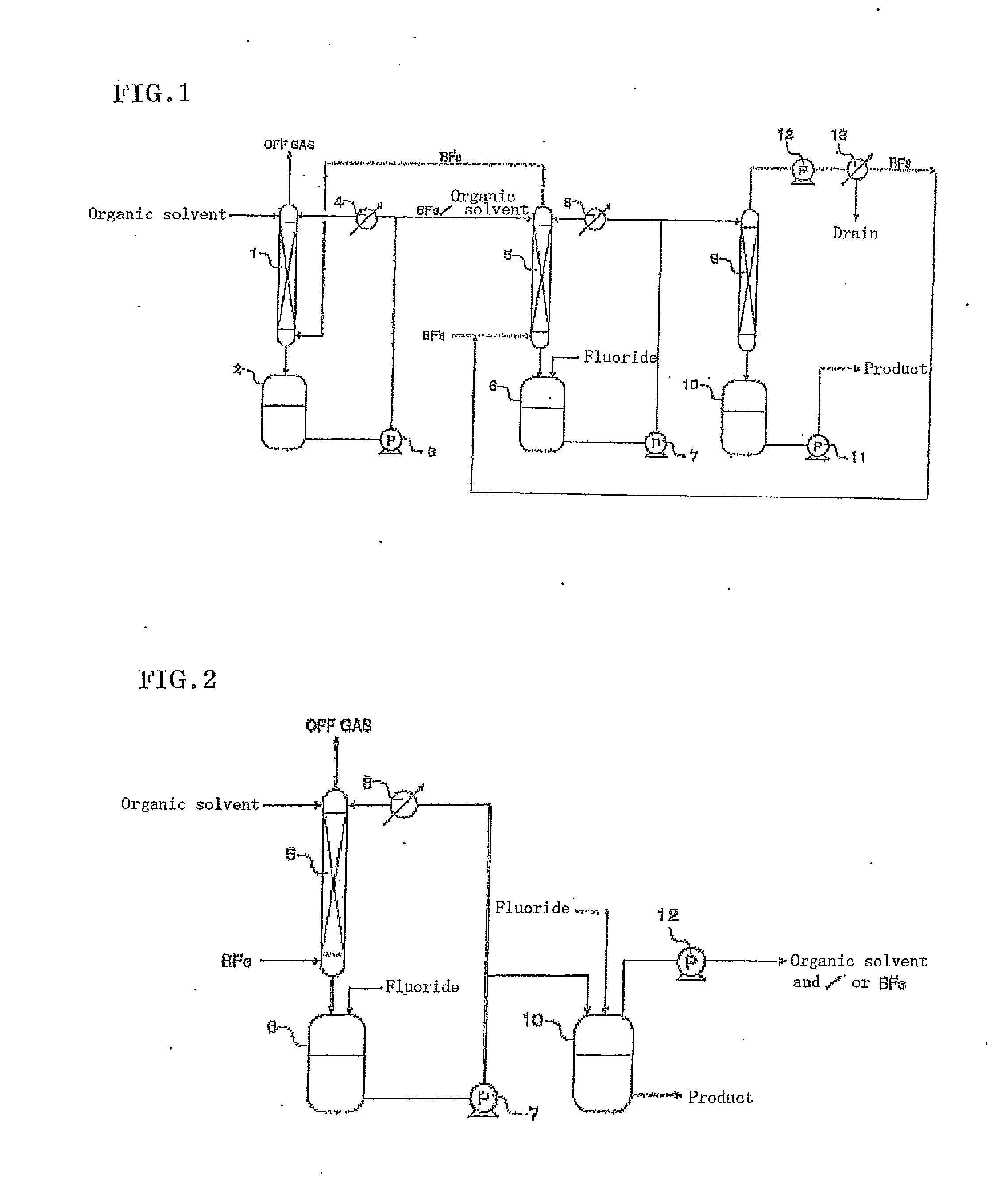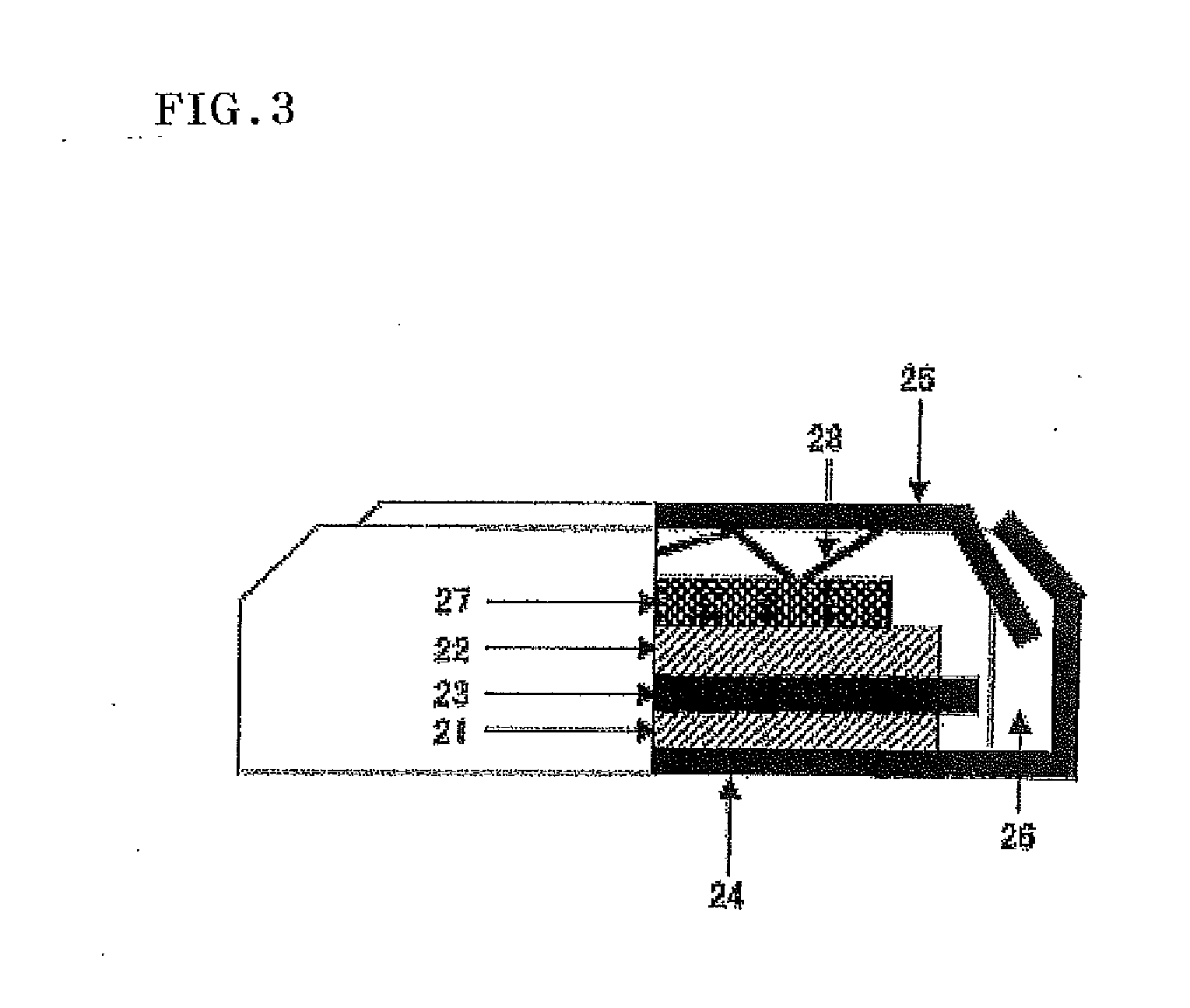Method for producing tetrafluoroborate
a technology of tetrafluoroborate and production method, which is applied in the manufacture of final products, electrochemical generators, chemistry apparatus and processes, etc., can solve the problems of reducing purity, production method is not necessarily satisfactory in view of the controllability of reaction, and it is difficult to produce tetrafluoroborate by a continuous process
- Summary
- Abstract
- Description
- Claims
- Application Information
AI Technical Summary
Benefits of technology
Problems solved by technology
Method used
Image
Examples
example 1
[0043]This example was performed using the apparatus shown in FIG. 1. Commercially-available, battery-grade, diethyl carbonate (9 ppmw in water content) was added in an amount of 3 L to the first and second tanks 2 and 6, respectively, each made of fluororesin, and then the operation of circulation through each absorption tower and each tank was started using the pumps 3 and 7. At this time, the flow rates of the pumps 3 and 7 were both 1 L / minute. The first tank 2 and the second tank 6 were kept at a constant temperature of 20° C. using the first cooler 4 and the second cooler 8, respectively.
[0044]Subsequently, the supply of boron trifluoride gas to the bottom of the second absorption tower 5 was started at a rate of 3.41 g / minute. After the boron trifluoride gas was absorbed into the organic solvent for 2 minutes, the supply of lithium fluoride to the second tank 6 was started at a rate of 1.30 g / minute. Sixty minutes after the start of the supply of lithium fluoride, the product...
example 2
[0047]This example was performed using the apparatus shown in FIG. 2. Commercially-available, battery-grade, diethyl carbonate (9 ppmw in water content) was added in an amount of 500 g to the second tank 6 made of fluororesin, and supplied to the top of the second absorption tower 5 and circulated by the pump 7. The second tank 6 was kept at a constant temperature of 20° C. using the cooler 8. Subsequently, boron trifluoride gas was supplied at a flow rate of 0.5 L / minute to the bottom of the second absorption tower 5 for 16.7 minutes, so that 22.6 g of boron trifluoride gas was introduced (the first step).
[0048]Subsequently, 8.0 g of lithium fluoride as the fluoride was gradually supplied to the second tank 6. The lithium fluoride quickly dissolved in the organic solvent containing the boron trifluoride and reacted with the boron trifluoride in the organic solvent. Thus, 530.6 g of a lithium tetrafluoroborate solution was obtained (the second step).
[0049]In addition, 500 g of dieth...
example 3
[0051]This example was performed using the apparatus shown in FIG. 2. Commercially-available, battery-grade, diethyl carbonate (9 ppmw in water content) and ethylene carbonate (7 ppmw in water content) were added in amounts of 250 g and 250 g, respectively, to the second tank 6 made of fluororesin, and supplied to the top of the second absorption tower 5 and circulated by the pump 7. The second tank 6 was kept at a constant temperature of 20° C. using the cooler 8. Subsequently, boron trifluoride gas was supplied at a flow rate of 0.5 L / minute to the bottom of the second absorption tower 5 for 25.5 minutes, so that 34.6 g of boron trifluoride gas was introduced (the first step).
[0052]Subsequently, 13.0 g of lithium fluoride as the fluoride was gradually supplied to the second tank 6. The lithium fluoride quickly dissolved in the organic solvent containing the boron trifluoride and reacted with the boron trifluoride in the organic solvent. Thus, 457.6 g of a lithium tetrafluoroborate...
PUM
| Property | Measurement | Unit |
|---|---|---|
| temperature | aaaaa | aaaaa |
| gas-liquid contact temperature | aaaaa | aaaaa |
| gas-liquid contact temperature | aaaaa | aaaaa |
Abstract
Description
Claims
Application Information
 Login to View More
Login to View More - Generate Ideas
- Intellectual Property
- Life Sciences
- Materials
- Tech Scout
- Unparalleled Data Quality
- Higher Quality Content
- 60% Fewer Hallucinations
Browse by: Latest US Patents, China's latest patents, Technical Efficacy Thesaurus, Application Domain, Technology Topic, Popular Technical Reports.
© 2025 PatSnap. All rights reserved.Legal|Privacy policy|Modern Slavery Act Transparency Statement|Sitemap|About US| Contact US: help@patsnap.com



